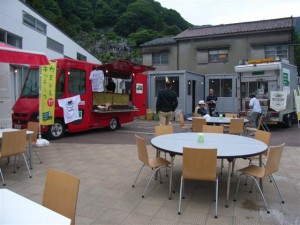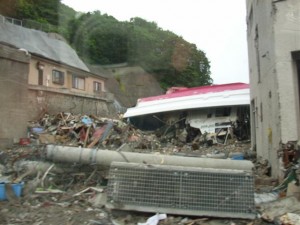A JCIE team visited several hard-hit towns Tohoku on June 17–19 in order to speak with NGO leaders, government officials, and local citizens about their communities’ needs and how outside aid can be directed most effectively. Following are the reflections of JCIE/USA Executive Director Jim Gannon.
Winding through the mountains on the tiny train to Kamaishi, everything looks normal. The first sign that anything is out of the ordinary is the small group of Self-Defense Force troops parked near the station and the three-story-high pile of rubble a few blocks down to the left, which is neatly placed in the yard of the Nippon Steel factory. Other than that, the town seems to be functioning normally, indeed with a lot of traffic for a Saturday morning. But when we take a left and walk over the bridge into the center of the old town, it feels as if we are descending into a nightmare. In the area that the tsunami swept through, the first floors of buildings have been left as ragged skeletons while everything looks to be fine from the second floor up. As we go farther downhill toward the port, the damage spreads to the second stories and then to the third. The rubble is everywhere in neat piles with crumpled cars and trucks sticking out at strange angles, mixed in with the odd boat. In places, it looks as though somebody drove a large snow plow through, just instead of snow they pushed pieces of homes and lives into large mounds on the side of the road.
We scramble up the stairs to the third floor of an old office building to meet with a local organization called the @Rias NPO Support Center. The first floor looks as though it used to be a retail shop, but the walls have been washed away, and people are now using it as a makeshift parking garage. When we get inside and sit down with the head of the organization, we are immediately captivated by his energy and optimism in talking about the future he envisions for Kamaishi. This is all the more striking because we know that his wife is among the city’s 400 missing, even though none of us dare to broach the topic. He had been running his nonprofit for years on the side of his daytime job, but he insists that he is no expert on NGOs. Rather, he says, he is just a baker who wants to reopen his cake shop and so he believes he needs to help create a new town where people are happy and feel comfortable walking around eating cakes. Kamaishi has been in decline for several decades as the local steel plant continued to shed jobs, so he sees this as a chance for the city to shift into new industries that can help counter long-term trends by giving families and young professionals a reason to stay. He explains that there needs to be a critical mass of stores and businesses to draw people back to town, so Japan Platform (which receives some support through JCIE’s fund) has just partnered with his group to rebuild the central shopping arcade. One problem, though, is that if local businesses that have had no income for three months cannot hang on through the next few months, there will be little to revitalize.
 In the middle of our meeting, we get a call to come see the Kamaishi mayor. The city has set up a disaster response center on the second floor of a tiny shopping mall, and Mayor Noda has a line of visiting groups waiting to see him. One of the problems, he says, is that many of the younger people have been leaving for years to look for work elsewhere. As a result, Kamaishi’s population resembles an upside-down pyramid, with many senior citizens at the top and a shrinking base of young workers. So, he argues, the biggest long-term challenge is to create jobs for young people.
In the middle of our meeting, we get a call to come see the Kamaishi mayor. The city has set up a disaster response center on the second floor of a tiny shopping mall, and Mayor Noda has a line of visiting groups waiting to see him. One of the problems, he says, is that many of the younger people have been leaving for years to look for work elsewhere. As a result, Kamaishi’s population resembles an upside-down pyramid, with many senior citizens at the top and a shrinking base of young workers. So, he argues, the biggest long-term challenge is to create jobs for young people.
Taro Edami of the Fuji Welfare Foundation has guided us around the city for the day, drawing on the connections he has from working with the city over the past three years on an economic revitalization initiative. His staff join from the local revitalization center he has helped establish, and I get a laugh when I ask one what he does over the weekend when he has time off. He jokingly responds, “Time off?” although he later admits that, since arriving in Kamaishi on April 1, he actually did allow himself to take off one weekend day.
 Edami explains that one fear is that, as time drags on, displaced residents living in temporary housing will eventually decide that there is no reason to stay in a town with no shops, restaurants, or jobs. He and his colleagues have devised an innovative “Kitchen Car Project” that is investing in the establishment of a small fleet of food trucks. These trucks are rented to local chefs and the plan is for them to gather in areas around town to provide low cost, high quality fare, in the process stimulating other local economic activity and making the city a more desirable place to live. Eventually, they hope, this will also provide a path back to restaurant ownership for the participating chefs.
Edami explains that one fear is that, as time drags on, displaced residents living in temporary housing will eventually decide that there is no reason to stay in a town with no shops, restaurants, or jobs. He and his colleagues have devised an innovative “Kitchen Car Project” that is investing in the establishment of a small fleet of food trucks. These trucks are rented to local chefs and the plan is for them to gather in areas around town to provide low cost, high quality fare, in the process stimulating other local economic activity and making the city a more desirable place to live. Eventually, they hope, this will also provide a path back to restaurant ownership for the participating chefs.


